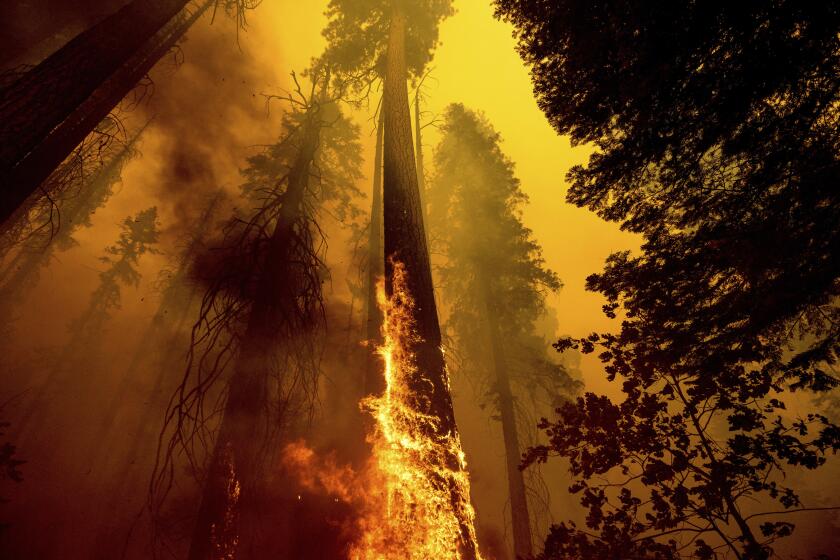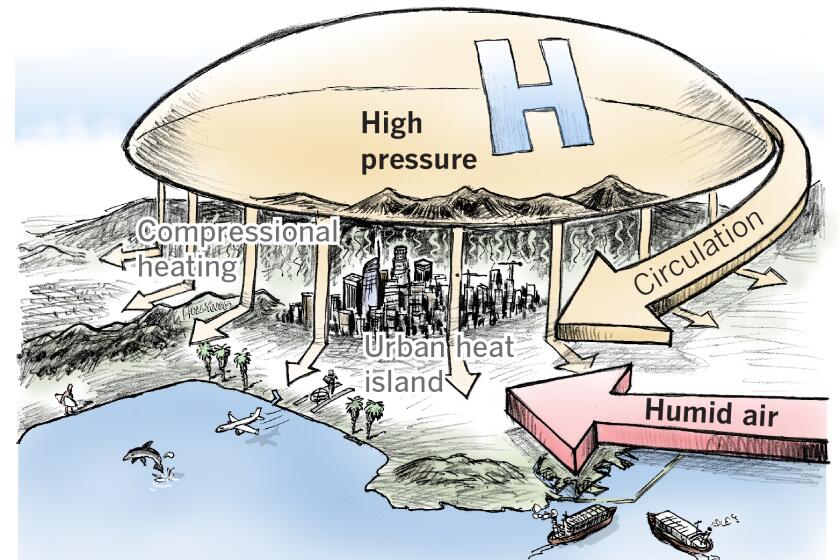Hundreds of giant sequoias may have burned to death in KNP Complex, Windy fires

at its base ahead of the KNP Complex fire.
- Share via
Hundreds of giant sequoias may have been killed after high-intensity flames from the KNP Complex fire tore through several groves of the massive trees in Sequoia and Kings Canyon National Parks.
Since igniting Sept. 9, the lightning-sparked blaze has encroached on 15 groves of the colossal trees, with two that appear to have been at least partially subjected to high-severity fire, said Christy Brigham, chief of resources management and science for the parks.
The extent of the damage to those groves — Redwood Mountain and Castle Creek — won’t be known until officials can survey the area, either from the air or the ground, she said.
Photos of the Windy fire near the Tule River Reservation in the Sequoia National Forest as crews from the Sierra Cobras and Roosevelt Hotshots fight it.
An enormous pyrocumulus formed Monday near the Redwood Mountain Grove, indicating the likelihood of extreme fire behavior.
Nate Stephenson, an emeritus scientist with the U.S. Geological Survey, said the observations suggested severe fire effects in the grove. “But as always, we won’t know what really happened until the smoke clears,” he wrote in an email.
Park officials on Wednesday wrote on Facebook that they suspect some groves were hit by flames severe enough “to result in sequoia mortality, possibly for significant numbers of trees (hundreds).”
The post said personnel were prioritizing and treating threatened groves outside the current fire perimeter, as well as “mopping up trees that need it,” extinguishing residual fires and cooling them down.
Crews in recent days have focused on protecting the well-known General Grant Tree from potential harm; a photo published by the National Parks Service showed a rigged sprinkler system spraying the colossal tree with water.
“It is not safe right now, nor is it our current priority to fully assess groves that have burned,” officials said in the Facebook post, adding that a complete assessment might not arrive until 2022, when the fire is completely extinguished and conditions permit access.
The blaze has seared nearly 86,000 acres and is only 11% contained.
In California and beyond, some people are deeply in grief, stunned that flames could again imperil some of Earth’s oldest living things.
Garrett Dickman, a botanist assigned to the Windy fire, which is burning south of the KNP Complex, said he is steeling himself for extensive devastation as groves are surveyed in burn areas spanning the Sequoia National Forest and Tule River Indian Reservation.
At least 74 large sequoias have been been killed in that fire, said Dickman, who typically works in Yosemite National Park.
Dickman has recorded incinerated and heavily scorched trees as he and a sequoia task force make their way through groves in rugged terrain. The team preps trees when possible ahead of advancing flames and triages those that have faced the fire.
“We’re taking such drastic measures to save these trees — and they deserve those drastic measures to be saved,” he said. Still, he’s worried the sequoia mortality level could be similar to that of 2020’s Castle fire, which took out 10% of the tree population.
With their towering canopies and thick bark, giant sequoias are adapted to withstand low-intensity fire, and even need it to reproduce. But ferocious climate-change-fueled fires of recent years have proved fatal to the trees experts once thought were impervious to flames.
Teresa Benson, supervisor for the Sequoia National Forest, vowed to release a full assessment of tree damage from the Windy fire once it is complete.
California’s worst heat waves arrive in a one-two punch — high temperatures combined with humid air from Baja.
The grim revelation of the trees’ fate arrives as both fires continue to burn through the southern Sierra Nevada, home to the majority of the world’s giant sequoia population. The KNP Complex fire spurred new evacuations Wednesday.
The Tulare County Sheriff’s Office ordered mandatory evacuations for residences on both sides of North Fork Drive from Yucca Creek to Sheep Creek. A road closure was also in effect at North Fork at Sheep Creek.
But good news may be on the horizon. Rain and snow are forecast for parts of the burn area Friday, and crews have made significant headway on the nearly 100,000-acre Windy fire, with containment reaching 75%.
Rain showers could develop late Thursday over the KNP Complex fire burn area to the north, with a potential for snow at higher elevations continuing through Friday, weather officials said.
Jim Dudley, a meteorologist assigned to the KNP Complex, said most of the area would see at least a tenth of an inch of rain, and possibly a quarter of an inch or more at higher elevations. Snow is expected in areas above 8,000 feet.
“A couple of inches of snow shouldn’t be ruled out by the time this system ends on Friday and moves out of the area,” he said, adding that there’s also a chance of thunderstorms.
Friday also could bring measurable rain over portions of the Windy fire, though it’s expected to be less than in the area to the north.
“The chance of the fire receiving a wetting rain” — a tenth of an inch or more — “is low,” an incident report said. If rain occurs, it would likely be along the northern perimeter of the blaze.
More to Read
Sign up for Essential California
The most important California stories and recommendations in your inbox every morning.
You may occasionally receive promotional content from the Los Angeles Times.

















